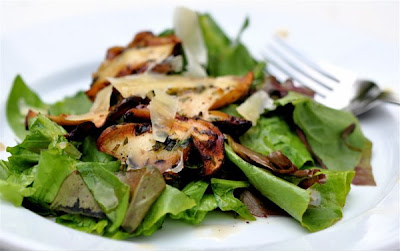 Some may call it heresy, but I’ll say it anyway: I sometimes prefer picking spring porcini to morels. Yes, finding morels is one of the great pleasures of foraging—and eating them is an unparalleled culinary treat. But hunting spring porcini means venturing deeper into more pristine wilderness at a time when the wildflowers are in full bloom and the songbirds in full throat.
Some may call it heresy, but I’ll say it anyway: I sometimes prefer picking spring porcini to morels. Yes, finding morels is one of the great pleasures of foraging—and eating them is an unparalleled culinary treat. But hunting spring porcini means venturing deeper into more pristine wilderness at a time when the wildflowers are in full bloom and the songbirds in full throat.
As with morels, you need an understanding of habitat conditions, tree composition, slope aspect, and so on, making a porcini hunt a challenging puzzle to figure out. I like to spend a few days roaming on the sunny side of the mountains, camping and hiking while I load up on a supply of spring kings to last me through the year.
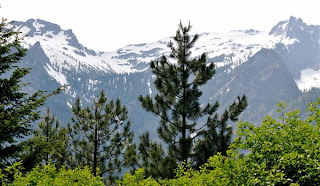
Usually I’ll start in the lower valleys and work my way up in elevation. Sometimes you don’t see the mushrooms at all; you need to look for a bump in the duff—affectionately known to hunters as a “mushrump”—that signals the growth of a bolete underneath. These are the ones you want, the firm young buttons. They’re also more likely to be bug-free than the older fully emerged mushrooms flapping in the breeze. Which brings me to one of the sad facts of porcini hunting: be prepared to toss a lot of mushrooms. Trim the end or slice in half and you’ll know right away: more than a few will be riddled with worm holes. I try to salvage what I can to dry for later; unblemished buttons get cooked fresh.
Until recently, picking spring porcini mushrooms was like waking up in the morning next to a stranger. A beautiful, nameless stranger. How embarrassing not to know a name! A few proposed appellations floated around the mushroom scene, with none sticking. Some called the mushroom a spring variant of Boletus edulis, others Boletus pinophilus. But the latter was a European species that didn’t seem to fit, and the former is only the most famous bolete of them all, the king bolete, a fall species that differs from its vernal cousin in a few dramatic ways. So most of us just referred to them as “spring kings” and left it at that.
Now David Arora, of Mushrooms Demystified fame, has offered a new name to put an end to the confusion. Boletus rex-veris (from the Latin, meaning “spring king”) would give the mushroom new species status.
 Spring kings differ from true king boletes (B. edulis) in a few striking ways. Most obvious is the timing; spring kings usually start fruiting on the east slopes of the Cascade and Sierra Nevada mountains a few weeks after the morels have started. In my area this means mid-June most years. They fruit underground and often don’t burst through the duff until fully mature, and they can also be found in clusters, sometimes with several specimens fruiting together from the same clump.
Spring kings differ from true king boletes (B. edulis) in a few striking ways. Most obvious is the timing; spring kings usually start fruiting on the east slopes of the Cascade and Sierra Nevada mountains a few weeks after the morels have started. In my area this means mid-June most years. They fruit underground and often don’t burst through the duff until fully mature, and they can also be found in clusters, sometimes with several specimens fruiting together from the same clump.
Some might argue that the spring king is not quite the equal of Boletus edulis, but it has good porcino flavor and can be quite firm and crunchy in the button stage. A few buttons can transform a simple camp dinner into something worthy of the best restaurants.
Camper’s Special Pig & Porcini Feast
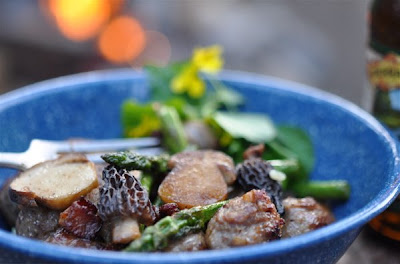
3-4 porcini buttons, trimmed and sliced 1/4 -inch thick
5-6 fresh morels, halved
1/2 lb Italian sausage, sliced
2 slices quality bacon, diced
1/2 lb asparagus, cut into thirds
1 cup rice
butter
cream
parmesan cheese
fresh herbs
wild violets for garnish
1. Make rice (or noodles). When done, add butter, cream, parmesan, and fresh herbs to taste for creamy texture. Keep covered.
2. While rice is cooking, saute diced bacon in a dab of butter until crispy. Set aside, leaving bacon fat in pan. Saute mushrooms, turning periodically, until browned. Set aside with bacon. Add sausage to pan and brown, then add asparagus and cook a few more minutes. Return bacon and mushrooms to pan for another minute or two. Serve over rice, then repair to cozy camp chair with a cold, hearty brew and a blazing fire to keep the wild animals at bay.
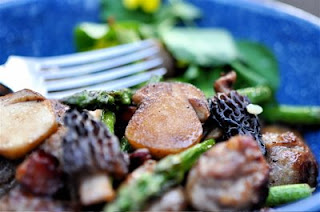
Like this:
Like Loading...
 I don’t visit the Rockies enough to have firm beliefs about the mushroom hunting possibilities here, but this is what I’ve gathered so far. August is generally the month to check your porcini spots. If it’s not a drought year and normal patterns of afternoon showers prevail, start looking a few days after the rains start. Go high. Get above the lodgepole pine forests into more mixed coniferous forests, especially spruce. Here’s a shot of a “king with a view” just below an 11,000-foot pass in the Zirkel Wilderness.
I don’t visit the Rockies enough to have firm beliefs about the mushroom hunting possibilities here, but this is what I’ve gathered so far. August is generally the month to check your porcini spots. If it’s not a drought year and normal patterns of afternoon showers prevail, start looking a few days after the rains start. Go high. Get above the lodgepole pine forests into more mixed coniferous forests, especially spruce. Here’s a shot of a “king with a view” just below an 11,000-foot pass in the Zirkel Wilderness. 














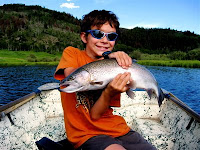









 3
3
